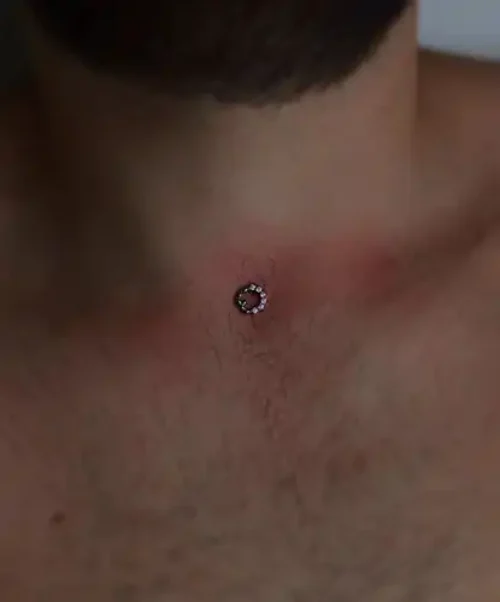Dermal Piercing in Nairobi, Kenya
Dermal Piercing is a type of body modification where a single-point piercing is embedded into the skin, creating the appearance of a stud or jewel sitting flush with the surface. Unlike traditional piercings, which have entry and exit points, dermal piercings involve placing an anchor beneath the skin to hold the jewelry in place.

Dermal Piercing
How It’s Done
- Preparation: The area is cleaned and sterilized to prevent infection.
- Anchor Placement: A dermal punch or needle creates a small hole in the skin where the anchor will be inserted.
- Jewelry Attachment: The anchor has a flat base that sits under the skin, and the visible jewelry (like a stud or gem) is screwed onto the top.
Dermal Piercing Variations
Placement Variations
- Facial Dermals:
– Cheeks: Highlighted by dimples or near the cheekbones for a chic look.
– Temples: Often referred to as “third eye” piercings, creating a striking effect.
– Around the Eyes: On the upper cheekbones or near the corners of the eyes for an elegant highlight. - Body Dermals:
– Chest: Popular for symmetrical designs or heart-shaped placements.
– Collarbone: Often mimics the look of natural body jewelry.
– Hips: Adds a stylish and edgy touch, often paired with crop tops.
– Lower Back: A discreet yet attractive placement option.
– Stomach/Abdomen: Creates a chic and playful look, often near the navel. - Uncommon Placements:
– Hands/Fingers: Jewelry sits elegantly on the fingers, resembling rings.
– Neck/Nape: Adds an edgy flair, particularly with larger or bold designs.
– Thighs: Often used for artistic or decorative patterns.
Dermal Piercing Procedure
The dermal piercing procedure typically involves several steps and should be performed by a professional piercer experienced in this type of piercing. Here’s an overview of the process:
- Consultation: Before the procedure, you’ll have a consultation with one of our piercers. During this time, you can discuss the placement of the dermal piercing, the type of jewelry you want, and any concerns or questions you may have.
- Preparation: Our piercer will clean the area where the piercing will be placed using an antiseptic solution. They may also mark the spot where the piercing will go using a surgical pen.
- Anesthesia (optional): Depending on your pain tolerance and the location of the piercing, our piercer may offer to apply a topical numbing cream or use a local anesthetic to minimize discomfort during the procedure.
- Incision: Using a sterile needle or dermal punch, our piercer will make a small incision in the skin where the dermal anchor will be inserted. The size of the incision will depend on the type and size of the anchor being used.
- Insertion of the Anchor: The dermal anchor, typically made of titanium or another biocompatible material, is then inserted into the incision. The anchor has holes or grooves to allow the skin to grow into it, securing it in place beneath the surface of the skin.
- Attaching the Jewelry: Once the anchor is in place, our piercer will attach the decorative top or gem to the exposed end of the anchor. This top can be screwed onto the anchor or attached using other methods, depending on the design of the jewelry.
- Aftercare Instructions: Our piercer will provide you with aftercare instructions to follow to promote healing and reduce the risk of infection or complications. This may include cleaning the piercing with saline solution, avoiding certain activities or products that could irritate the piercing, and keeping the area dry and clean.
- Follow-up: Our piercer may schedule a follow-up appointment to check on the healing progress of your dermal piercing and make any necessary adjustments to the jewelry.
It’s important to choose a reputable piercer who follows proper sterilization and hygiene practices to minimize the risk of infection and other complications. Be sure to follow all aftercare instructions carefully to ensure proper healing of your dermal piercing.
Considerations before getting a Dermal Piercing
Before getting a dermal piercing, there are several important considerations to keep in mind:
- Placement: Think carefully about where you want the dermal piercing to be located. Consider factors such as visibility, potential interference with clothing or accessories, and the likelihood of the piercing being subject to trauma or irritation.
- Professional Piercer: At Rebel Inks Tattoos, Tattoo Removal, and Body Piercings Parlour we have reputable and experienced piercers who follow strict hygiene practices and use high-quality, biocompatible materials. Research piercers in your area and read reviews from previous clients to ensure you’re selecting a skilled professional.
- Potential Risks: Understand the potential risks and complications associated with dermal piercings, including infection, rejection, migration, scarring, and embedding of the jewelry. While these risks can be minimized with proper care and attention, it’s important to be aware of them before undergoing the procedure.
- Pain and Discomfort: Be prepared for some level of discomfort or pain during the piercing procedure. While pain tolerance varies from person to person, dermal piercings typically involve less pain than traditional piercings since they don’t penetrate as deeply into the skin.
- Healing Time: Dermal piercings can take several weeks to months to fully heal. During the healing process, it’s important to follow proper aftercare instructions provided by your piercer to reduce the risk of complications and promote optimal healing.
- Lifestyle Considerations: Consider how a dermal piercing may impact your lifestyle and daily activities. Certain activities or habits, such as contact sports, wearing tight clothing, or frequent exposure to water (e.g., swimming), may need to be adjusted or avoided during the healing period.
- Jewelry Options: Explore different jewelry options available for dermal piercings, including decorative tops or gems. Choose jewelry that reflects your personal style and preferences while also considering factors such as material, size, and compatibility with your skin.
- Budget: Consider the cost associated with getting a dermal piercing, including the initial procedure fee and the price of jewelry. While it’s important not to compromise on quality when it comes to piercing, be mindful of your budget and choose options that are affordable without sacrificing safety or quality.
- Commitment to Aftercare: Understand that proper aftercare is essential for the success of your dermal piercing. Be prepared to dedicate time and effort to caring for your piercing during the healing process, which may involve cleaning it regularly, avoiding certain activities or products, and seeking professional assistance if any issues arise.
Personal Preference: Ultimately, the decision to get a dermal piercing should be based on your personal preferences, style, and comfort level. Take the time to carefully consider whether a dermal piercing aligns with your aesthetic goals and fits into your lifestyle before proceeding with the procedure.
Pain and Healing for a Dermal Piercing
Pain Level
The pain experienced during a dermal piercing is subjective and depends on:
- Individual Pain Tolerance: Some people find it mild, while others describe it as more intense.
- Placement Area: Fleshier areas (e.g., hips, cheeks) tend to hurt less, while bony or sensitive areas (e.g., collarbone, face) might cause sharper pain.
- Piercing Technique:
– Using a dermal punch is typically faster and less painful.
– A needle method may involve slightly more pressure.
Most individuals describe the pain as a sharp pinch or quick sting, followed by pressure as the anchor is inserted. The sensation subsides quickly after the procedure.
Healing Process
The healing timeline for dermal piercings is about 1–3 months, but complete healing can take up to 6 months, depending on aftercare and placement.
Stages of Healing
- Initial Phase (1–2 Weeks):
– The area may be red, swollen, or tender.
– Light scabbing around the jewelry is normal. - Intermediate Phase (3–6 Weeks):
– Swelling decreases.
– The anchor starts integrating with the skin tissue. - Final Phase (2–6 Months):
– The skin fully heals around the anchor.
– No pain, redness, or discharge should be present.
Factors That Affect Healing
- Placement: Areas with more movement (e.g., hands, hips) may heal slower.
- Aftercare: Consistent cleaning and avoiding irritation are key.
- Lifestyle: Activities that put pressure or friction on the piercing can delay healing.
Common Healing Challenges
- Migration or Rejection: Occurs when the body pushes the jewelry out. This may happen if the placement is shallow or the body reacts to the anchor.
- Keloids or Scarring: Can occur if the piercing is irritated or improperly cared for.
- Infections: Result from bacteria entering the wound; maintain strict hygiene to prevent this.
Dermal Piercing Aftercare Guide
Proper aftercare is essential to ensure your dermal piercing heals well and looks its best. Follow these steps to minimize complications and maintain a healthy piercing.
Immediate Aftercare (First 2 Weeks)
- Cleaning Routine:
– Use a sterile saline solution or a piercing aftercare spray twice daily.
– Gently clean around the jewelry using a clean cotton swab or pad.
– Avoid over-cleaning, as this can irritate the skin. - Protect the Piercing:
– Cover the area with a breathable bandage for the first few days to protect against snagging or contamination.
– Avoid touching or twisting the jewelry with unwashed hands. - Manage Swelling:
– Apply a cold compress wrapped in a clean cloth to reduce swelling if needed.
– Avoid anti-inflammatory creams or medications unless advised by a professional.
Ongoing Care (Weeks 3–6)
- Maintain Hygiene:
– Continue cleaning twice a day with saline solution.
– Keep the area dry; pat gently with a clean tissue after cleaning. - Avoid Irritants:
– Keep the piercing free from makeup, lotions, or perfumes.
– Protect the area from excessive water exposure (e.g., swimming pools, hot tubs). - Clothing Considerations:
– Wear loose-fitting clothing to minimize friction.
– Avoid tight or restrictive items that might catch on the jewelry.
Long-Term Aftercare (After 6 Weeks)
- Minimize Pressure and Friction: Be mindful of activities that could snag or press on the jewelry (e.g., sports, rough fabrics).
- Monitor Healing Progress:
– Ensure there is no persistent redness, swelling, or discharge.
– Avoid removing the jewelry prematurely; consult your piercer if you wish to change the top piece. - Keep It Clean: Clean the area occasionally to prevent buildup of dead skin or oils.
What to Avoid
- Touching the Piercing: Hands carry bacteria that can cause infections. Only touch the piercing when cleaning it, and always wash your hands first.
- Alcohol or Hydrogen Peroxide: These can dry out and irritate the skin.
- Sleeping on the Piercing: Avoid putting pressure on the piercing by sleeping on the opposite side.
- High-Impact Activities: Activities that risk snagging or hitting the jewelry should be avoided until fully healed.
Signs of Infection or Issues
Seek professional help if you notice:
- Persistent or worsening redness and swelling.
- Green or yellow discharge with an odor.
- Intense pain or warmth around the area.
- Signs of migration or rejection, such as the anchor becoming visible.
Dermal Piercing Jewelry Guide
Dermal piercing jewelry is designed to sit flush with the skin, offering a unique and stylish look. Choosing the right jewelry is essential for comfort, aesthetics, and healing success. Here’s a detailed breakdown of dermal piercing jewelry types, materials, and customization options.
Components of Dermal Piercing Jewelry
- Anchor (Base):
– A small, flat piece implanted beneath the skin to hold the jewelry in place.
– Made from biocompatible materials to reduce the risk of irritation or rejection.
– Available in flat, domed, or perforated designs to encourage tissue healing and secure placement. - Top (Visible Jewelry):
– The decorative part that screws into the anchor.
– Interchangeable, allowing you to switch designs without removing the anchor.
Types of Dermal Jewelry Tops
- Gemstone Tops:
– Popular choices for a glamorous look.
– Available in a range of colors and cuts (e.g., clear crystals, opals, or cubic zirconia). - Flat or Matte Tops:
– Simple, understated designs for a minimalist aesthetic.
– Suitable for professional settings or low-key styles. - Shaped Tops:
– Hearts, stars, flowers, or geometric shapes.
– Great for adding personality or a playful touch. - Themed Tops: Seasonal or novelty designs (e.g., snowflakes, skulls, or holiday themes).
- Cluster Tops: Multiple gems or designs grouped into a single top for a more dramatic appearance.
Material Options
Choosing high-quality materials is essential for healing and long-term wear.
- Titanium:
– Hypoallergenic and lightweight, ideal for sensitive skin.
– Corrosion-resistant, making it perfect for long-term wear. - Surgical Steel:
– Durable and cost-effective.
– Suitable for most skin types but may not be ideal for those with metal sensitivities. - Gold:
– Available in 14k or 18k for luxury options.
– Avoid gold-plated jewelry during healing, as it can wear off and irritate the skin. - Bioplast or PTFE:
– Flexible, hypoallergenic options that reduce pressure on healing piercings.
– Often used in medical-grade jewelry. - Platinum:
– High-end, hypoallergenic material with a polished finish.
– Ideal for those seeking a premium and durable option.
Jewelry Size and Fit
- Anchor Base Size: Usually small and discreet to minimize pressure under the skin.
- Top Size: Ranges from micro (2–3 mm) to statement pieces (5–8 mm), depending on the desired look and placement.
Customization Options
- Engraved Tops: Personalized designs, such as initials or symbols.
- Color-Coated Jewelry: Anodized titanium or colored gems for a vibrant appearance.
- Glow-in-the-Dark: Unique pieces for a fun and playful style.
- Magnetic Tops: Easy-to-swap designs without unscrewing.
Jewelry Trends
- Constellation Patterns: Clustered dermals resembling star constellations.
- Biophilic Designs: Nature-inspired shapes like leaves, flowers, or suns.
- Minimalist Looks: Tiny, flat discs or clear gems for subtle elegance.
Cost of a Dermal Piercing in Nairobi, Kenya
The cost of a dermal piercing varies based on location, studio reputation, and jewelry type. Here’s a breakdown to help you understand the pricing structure:
Average Cost of a Dermal Piercing
- General Price Range:
– Ksh. 3,000 – Ksh. 5,000: Standard pricing for one dermal piercing, including basic jewelry.
– Prices can go higher depending on the piercer’s experience and the complexity of the placement. - Jewelry Upgrades:
– Basic jewelry is often included in the initial price.
– Upgraded materials (e.g., titanium, gold, custom designs) can add Ksh. 500 – Ksh. 1,000 to the cost. - Studio Fees: At Rebel Inks Tattoos, Tattoo Removal, and Body Piercings Parlour we migh charge additional fees for consultation or using premium equipment, ranging from Ksh. 500 – Ksh. 1,000
- Aftercare Products: Saline solution or piercing aftercare sprays are usually sold separately for Ksh. 500 – Ksh. 1,000
Dermal Piercing Cost Breakdown Table
Service Component | Estimated Cost (KSh) | Details / Notes |
Dermal piercing (procedure + basic jewelry) | 3,000 – 5,000 | Standard rate at reputable Nairobi studios like Rebel Inks |
Jewelry upgrades (titanium, gold, custom) | 500 – 1,000 | For hypoallergenic or decorative options |
Studio consultation/premium service fees | 500 – 1,000 | Applies to higher-grade placement or specialist attention |
Aftercare kit (saline solution, sprays) | 500 – 1,000 | Often sold separately |
Total estimated range (all-inclusive) | 3,500 – 7,000 | Full package with upgrades and aftercare |
Factors That Influence Cost
- Studio Reputation:
– High-end or well-established studios with experienced piercers may charge more but often provide better safety and quality. At Rebel Inks Tattoos, Tattoo Removal, and Body Piercings Parlour we have experienced professionals who offer quality and premium services.
– Smaller or newer studios might offer lower prices, but always ensure they follow proper hygiene standards. - Location: Studios in metropolitan areas or upscale neighborhoods tend to charge more than those in smaller towns. Rebel Inks Tattoos, Tattoo Removal, and Body Piercings Parlour is located in the heart of the Central Business Disrict (CBD) in Nairobi, Kenya, and is easily accessible to both locals and foreigners in the country.
- Jewelry Quality: Titanium, surgical steel, or gold jewelry increases costs compared to cheaper alternatives like stainless steel.
- Placement Complexity: Some placements, such as those on bony or curved areas, require more skill and may cost extra.
- Quantity: At Rebel Inks Tattoos, Tattoo Removal, and Body Piercings Parlour we sometimes offere discounts for multiple piercings done in a single session.
Additional Costs
- Touch-Up or Replacement: If the piercing gets rejected or needs to be re-done, studios may charge for the procedure again (usually at a discounted rate).
- Changing Jewelry: Switching to new tops after healing may cost Ksh. 500 – Ksh. 1,000, depending on the design and materials.
Cost-Saving Tips
- Ask About Packages: At Rebel Inks Tattoos, Tattoo Removal, and Body Piercings Parlour we might offer discounts for multiple dermal piercings or group bookings.
- Check for Promotions: Look out for seasonal deals or social media promotions from reputable studios.
- Verify Hygiene Standards: Avoid studios that compromise on cleanliness or safety for lower prices. Paying more for proper hygiene is worth the investment.

Possible side effects of Dermal Piercing
While dermal piercings are generally safe when done by a professional, they do come with potential risks and side effects. Understanding these can help you take precautions and identify issues early.
- Infection
– Symptoms: Redness, swelling, pain, heat around the area, and pus-like discharge.
– Cause: Bacteria entering the piercing during or after the procedure.
– Prevention:
→ Maintain proper aftercare by cleaning with saline solution.
→ Avoid touching the piercing with dirty hands or exposing it to unsanitary environments. - Rejection
– What Happens: The body treats the anchor as a foreign object and pushes it out, leading to the jewelry being expelled.
– Causes:
→ Shallow placement of the anchor.
→ Individual skin type or sensitivity.
→ Excessive movement or pressure on the piercing.
– Signs: Jewelry becoming more visible under the skin or appearing to “grow out.” - Migration
– What Happens: The piercing shifts from its original placement.
– Causes:
→ Improper insertion technique.
→ Physical strain or movement around the area.
– Signs: Jewelry no longer aligned with its original position. - Scarring
– Types:
→ Hypertrophic Scars: Raised scars that form around the piercing site.
→ Keloids: Larger, overgrown scars that can develop in some individuals.
– Prevention:
→ Avoid irritating the piercing by snagging it on clothing or accessories.
→ Use high-quality materials to minimize skin reactions. - Pain and Prolonged Soreness
– Normal: Mild discomfort during the healing process.
– Abnormal: Persistent or worsening pain may indicate an issue, such as an infection or improper placement. - Skin Irritation or Allergic Reactions
– Symptoms: Itching, redness, or a rash around the piercing.
– Causes:
→ Allergies to certain metals (e.g., nickel).
→ Use of irritating products like alcohol-based cleaners.
– Prevention:
→ Choose hypoallergenic materials like titanium or surgical steel.
→ Stick to saline solution for cleaning. - Snagging or Trauma
– What Happens: The jewelry gets caught on clothing, towels, or hair, causing irritation or tearing.
– Prevention:
→ Wear loose clothing during healing.
→ Be mindful when drying off or changing clothes. - Prolonged Healing or Non-Healing
– Cause: Improper aftercare, poor-quality jewelry, or placement in a high-movement area.
– Signs: Persistent redness, swelling, or discharge beyond the normal healing timeline. - Anchor Displacement
– What Happens: The anchor becomes dislodged from its position under the skin.
– Causes:
→ Physical trauma or excessive movement.
→ Weak or poorly designed anchor. - Nerve Damage (Rare)
– What Happens: Damage to nearby nerves during insertion, leading to numbness or tingling.
– Prevention: Ensure the piercing is done by a qualified professional with anatomical knowledge.
When to Seek Medical Attention
- Severe pain, excessive swelling, or pus-like discharge.
- Jewelry appearing to move out or become fully exposed.
- Fever or flu-like symptoms indicating a systemic infection.
Testimonials
After he pierced my industrial piercing and seeing his amazing work, I feel even more excited about getting my tattoo with him in January. I’m really looking forward to it!
I am extremely happy with my new 'Safari' tattoo from Eric at Rebel Inks! The quality of the artwork is fantastic. Eric is a true professional and an amazing artist.
The preparation and design process was thorough and collaborative. He was very patient with my specific requests, including making sure all the elements, which hold personal meaning, were perfect.
The service was friendly and highly professional from start to finish. Despite the 8-hour session, Eric was a pleasant person to spend the time with.
The aftercare guidance and follow-up have been excellent and careful, which has made the healing process easy and better than expected.
I highly recommend Eric for anyone looking for a thoughtful, talented, and caring tattoo artist.
I recommend them 💯
I would definitely recommend if you’re thinking of getting a piercing!
The staff were super friendly, explained everything clearly, and made me feel so at ease. They answered all my nervous questions (and I had many questions),
They walked me through the whole process, gave detailed aftercare instructions, and even followed up afterward to check how I was healing 🫶
Clean, professional, and full of good vibes.
Would 100% recommend . Definitely making a second trip here.
This was the second tattoo I got and I wish I could have come to Eric for my first one! He gave me really great after-care directions for the tattoo as well as a little jar of his own Vaseline-type stuff to put over my tattoo while it was healing! He even put second skin over my tattoo so that I didn’t have to worry about it for the first few days. Now THAT’S good service. My first tattoo artist didn’t do none of that lol.
After the session Eric didn’t rush me and my friend out, he chatted with us and even when he found out I was an artist too— really encouraged me to keep creating and to find a community of artists to support me. I almost cried because I’ve had such a hard time with my own art the past couple of years, it meant so much to me to have a fellow very talented artist say that to me. 🤍🤍🤍
Eric you’re amazing, don’t ever stop creating and just know you’ve impacted lives all over the world!🫶🏻 thanks so much for everything!!
From the moment I walked in, Eric was professional, welcoming, and attentive. He made sure I was comfortable throughout, provided everything I needed, and explained every step of the process. The tattooing itself was unbelievably smooth - I genuinely felt no pain compared to my previous tattoos over the last 22 years.
Eric also gave me excellent aftercare guidance and products, and thanks to that, my tattoo healed beautifully. The attention to detail, precision, and shading are absolutely stunning. This is hands-down the best tattoo I've ever had, and I will be flying back to Nairobi for any future ink.
If you want incredible art, a professional experience, and a talented artist who truly cares about his clients, Rebel Ink is the place to go!
From start to finish, the service was exceptional. The piercer was professional, knowledgeable, and made me feel completely comfortable. The cleanliness of the place was above and beyond — everything was spotless and hygienic, which really put me at ease. Highly recommend for anyone considering a piercing!
Shout out to Eric😘
We ended up changing the jewelry three times to ensure I had the best fit and avoided any signs of rejection, and he always listened to my suggestions as a client, which I really appreciated. Now, three months in, my piercing is healing beautifully, with no sign of rejection. Highly recommend for anyone who values a piercer who cares about your comfort and healing journey!
What stood out the most was the aftercare Eric checked in with me even three weeks later to see how the tattoo was healing. That kind of follow-up shows how much he truly cares about his work and his clients.
I’m very satisfied and will definitely be coming back for my next piece. Highly recommend!
The piercing wasn't as painful as I had thought and the process was quick and satisfactory. I love it!!!
The piercing is healing well thanks to the aftercare instructions and follow-up. I would highly recommend Rebel Inks
Eric also did a belly button piercing for a friend, guiding her through the process, doing the piercing and then explaining the after care to her.
The shop is on the 3rd floor, with the entrance to the stairs near an alleyway on the left. The shop is perfect size, clean, and attractive looking. The mural is pretty dope.
Thank you for the amazing service! 🔥👅✨
I got piercibgs there and the process was really good. My biggest concern was hygiene but that wasn't an issue at all, they use new needles and they sanitize them.
The service itself was also welcoming.
I was informes of everything i needed to know beforehand.
10/10 would recommend!
Eric was so calm and patient with my almost 2 year old lady. It was such a clean and hygienic process. We will definitely be back for our second rounds of piercings and maybe even another tattoo!
They assess the area before any art and advise one accordingly. They also give one post clean up process and also do a check up after the body art projects. Overall, I loved my experience and I’m hooked. 👍
Will definitely come back next time I’m in town 🙂
He listened to what I actually wanted and made sure he could fit in the time before I flew back home.
The shop is clean & private and is easy enough to find.
Eric has even checked in a couple of times since to make sure all is good.
I would totally recommend Eric! I absolutely love my Elephants!
I had a very easy healing period and always follow up from Eric to check on my progress...I would highly recommend if you are a first timer because from my experience all went very well and attention to detail
Thank you for a good job and looking forward to send all my friends your way
And all the best with the new year 2025!
From the moment I walked in, the staff was super friendly and made me feel at ease. The studio had a clean, professional atmosphere, which immediately put me at ease. My piercer was incredibly skilled and explained every step of the process, ensuring I was comfortable the entire time. The piercing was quick and practically painless, and the aftercare instructions were clear and easy to follow. I can tell they really care about the health and safety of their clients.
Overall, a fantastic experience—I highly recommend Rebel Inks and Tattoos for anyone looking to get pierced or tattooed!
They do follow up after their services
Eric's Studio isn’t just a place to get a tattoo—it’s an experience. The combination of professionalism, artistic talent, and a welcoming environment makes it a standout destination for anyone considering a tattoo.
I highly recommend Eric’s Studio to both first-timers and seasoned tattoo enthusiasts. If you’re looking for a high-quality tattoo and an enjoyable experience, this is the place to go.
I would definitely recommend their services again and again
Thank you Rebel Ink
My piercings are healing ❤️🩹 well
I would 💯 recommend
I will definitely come back for more .
Two, all the equipments he used for the piercings were new and/or sterilised.
Three, the parlour itself was very clean and was up to par with the hygiene standards.
Four, Eric provided effective aftercare instructions, making sure I knew exactly how to take care of my new piercings and he kept in touch and continues to do so, to check on the healing progress.
I highly highly highly recommend this place!!!
Would definitely recommend them to friends and go back for other piercings
Not only was the piercing process smooth, but he also provided thorough aftercare instructions, making sure I knew exactly how to take care of my new piercings. What really impressed me was that he keeps in touch to check on how the healing is progressing – a sign of true care for his clients.
The shop maintains a high standard of hygiene, and the atmosphere is welcoming and comfortable, which really added to the positive experience. I highly recommend this place to anyone looking for a professional and caring experience. I’ll definitely be coming back for any future piercings!
My appreciation for the excellent customer service I received. The follow-ups were prompt, and I truly appreciated the gentleness and professionalism throughout. Thank you!"
"Looking for professional eyebrow microshading removal? Look no further!"
The customer care is top tier 👌🏾👌🏾.
Wonderful place to get tattoos and piercings. 💯💯
Eric goes ahead to follow up on his clients progress and gives good advice each time I reach out to him.
I would recommend Reble tattoos anytime.
Good job bro we really appreciate.
Ohh and the price is very fair.
The environment was clean , procedure was sterile and the jewelry used are of the best quality.
He followed up with me during the healing process, he educated me on what I needed to do for my aftercare.
Eric is confident, skilled , experienced and the best piercer. Highly recommend Rebel inks.✨
Definitely recommend!
Great experience.
Eric definitely know what he is doing .
I got exactly what I wanted 2 tiny tats on the same finger .
He was kind and patient throughout the session.
Healing process has been good .
Aftercare services were given and regular checkups on the healing process were done.
I would 💯recommend.
Eric gave me the best reception as it was my first time there,and made me trust him all the way. I appreciate good services.
There services are also affordable not to forget 😊.
He was also invested in the aftercare and would ensure I follow the do's and don'ts in taking care of the tattoo and ensuring proper healing and maximum ink retention.
Would highly recommend Rebel Inks Tattoos.
Rebel Inks Tattoo offer the best,affordable and quality tattoo removal services.If you have unwanted ink,choose Rebel Inks Tattoo,they're the best of the best and the professionalism is a top notch.They ensure you're free from unwanted ink with their Laser Tattoo Removal Technology...
I did a Laser Tattoo Removal with them and i can attest they're the best....
Kudos Eric...
I highly recommend.
It was a generally good experience with good hygiene during the piercing process and has been a smooth healing process.... 10/10
tips. Highly recommend 👍🏽
100% recommendable.
I was particularly impressed with Eric's attention to hygiene. He thoroughly cleaned the room before I entered, sanitized all of the equipment he would be using, and changed gloves between each ear. This level of cleanliness gave me great confidence in his professionalism.
Eric's commitment to customer service did not end on the day of the piercing. He followed up with me regularly throughout the healing process to ensure that I was following the aftercare instructions and that my earlobes were healing properly.
I highly recommend Rebel Inks to anyone in Nairobi who is considering getting a piercing. Eric is a highly skilled and experienced piercer who takes great pride in his work.
So I Check all the boxes below and more:
Customer Care: ✔️
Professionalism : ✔️
Cleanliness ✔️
Price: ✔️
After care service ✔️
Thanks and good job, Eric
The place is neat and clean and the equipments he used were also fine standards. Really appreciate his following up with me on the healing 🤗
I WOULD HIGHLY RECOMMEND THEIR SERVICES to everyone. Actually what you see on their website is EXACTLY what you will get. Keep up the good work Rebel inks Tattoos.
The infection is now gone. I would definitely recommend!
Can recommend this place totally and would go back there anytime!
Thanks!
Get In Touch
For more information on the list above and any other special services,please call or come in for free consultation
OUR LOCATION
Areas We Serve
NAIROBI
KIAMBU
KAJIADO
MACHAKOS









































































































































































































































